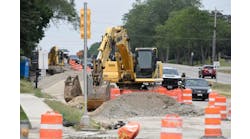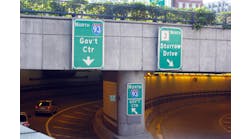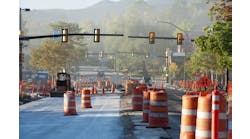Urban neighborhoods are cultural treasures. Too often, however, they become buried under the soul-sapping sameness of retail and fast-food franchises. Such has not been the fate of Old Irving Park, which began as a wealthy suburb of Chicago in the mid-19th century. Waves of immigrants have left indelible marks on this vibrant, near-northwest-side neighborhood—Germans and Swedes at the turn of the century, Poles and Germans in the 1920s and Hispanics from Central and South America over the past two decades.
When Wight & Co. was charged with designing a multiphased project for Irving Park Road, a primary consideration was integrating the neighborhood’s main roadway with its rich cultural heritage. The focal point for this effort was a 360-ft-long underpass beneath the Kennedy Expressway and Chicago Transit Authority (CTA) and Metra train lines. Each day, tens of thousands of residents walk or drive by this site, which, like many city underpasses, is dark and unattractive. Its appearance also was detrimental to businesses on both sides of the underpass.
“Our goal was to transform this area from a barrier to a gateway,” said Janet Attarian, project director for the Chicago Department of Transportation (CDOT). “We needed a design that would be affordable, dramatic and easily maintainable.”
To meet this challenge, Wight has worked closely with CDOT, other transportation officials, civic leaders and the Irving Park Historical Society. The first streetscape phase of the project was completed without a hitch, and Phase Two, the underpass “facelift,” will be done this fall. Collaborative teamwork and simple yet effective design enhancements have helped revitalize a neighborhood by connecting it to its historical roots.
Three phases, myriad challenges
Like the neighborhoods it connects, Irving Park Road is the embodiment of diversity. This bustling thoroughfare is an eclectic blend of businesses, bus stops, residences, shops, restaurants, other commercial enterprises and architectural landmarks.
The first and third phases of this project involve fairly basic streetscape and landscape architecture. Phase One, which began on the eastern edge of Irving Park Road near the north branch of the Chicago River, was completed several years ago. Streetscape enhancements for this primarily residential area included new decorative street lighting, planter boxes, improved surface drainage and reconstructed sidewalks and gutters. Other additions were street furniture (benches, bike racks, trash receptacles, etc.) and decorative brick piers with lighting and signage identifying the community.
Phase Three, which will begin just west of Old Irving Park, also will be pedestrian-friendly, with many of the Phase One enhancements. The west end of this section borders historic Portage Park, where another viaduct will be developed into a gateway between the two communities.
Phase Two (the underpass section) is a full-blown architectural and streetscape project that takes into account existing bridges, buildings, retaining walls and passageways to two different train platforms. In addition, four government agencies—CDOT, the CTA, Metra and the Illinois Department of Transportation (IDOT)—own the real estate and structures.
The key objective for this phase is to transform a dark, dank and sometimes intimidating walkway under concrete bridges into an appealing venue where pedestrians and commuters will feel safe and comfortable. Exacerbating this challenge is the cold, harsh physical environment with its auto and bus fumes and lack of natural lighting. In addition, CDOT and the CTA need all underpass enhancements to be essentially maintenance-free for at least 15 years. Lastly, this section of the road has been the heart of the Old Irving Park business district for more than a century, and groups such as the Irving Park Historical Society want this high-traffic location to have commercial and public appeal.
Telling a story
An active participant on this project from its outset, the Irving Park Historical Society provided Wight with a wealth of information. Formed in 1984 to help preserve the neighborhood’s heritage, the society wants to use the underpass site to pay homage to Old Irving Park’s founding fathers and rich history.
The site will feature eight history panels, each telling an aspect of Old Irving Park’s story—its pioneers, buildings, churches, commerce, social halls, schools and influential leaders. The satiny, bronze plaques are made of anodized aluminum and feature etched-in text and graphics. The rugged panel system, also used in U.S. National Parks, is as vandal-proof as is possible with public art. For optimal visibility, Wight will prominently place the large (24 in. wide x 36 in. high) panels along the sidewalk under the expressway bridges.
Sidewalk construction has been completed, widening the walkways by 5 ft and providing more space for bike racks and trash receptacles. The sloping concrete walls under the bridges were cut back to leave a decorative wall that serves as the base for the 9-ft-high columns featuring the historical panels. Fencing also was installed between the columns to prohibit access to the underside of the bridges.
“The cleaner, wider sidewalks have already made a dramatic difference in improving the atmosphere for pedestrians,” said Attarian. “We hope this will increase commercial activity on both sides of the underpass.”
To further highlight the neighborhood’s unique heritage, the site will have “Old Irving Park” identifiers in several places. Some will be prominent monuments that will become architectural landmarks for the neighborhood and constant reminders of its storied history. The sign on the east end, for example, will be on top of a 19-ft tower that will be seen daily by thousands of pedestrians and drivers.
Show some toughness
With four agencies providing input for different parts of the physical infrastructure, a major challenge was finding solutions that would be acceptable to all parties. For example, although hanging lights on the bridge columns to brighten the space was considered, IDOT decided this was not feasible. Even something as simple as the color of the underpass was determined by what paint colors were available on the CDOT trucks that are used to combat graffiti.
The severity of the physical environment and its limited space affected both design and construction. Materials had to be strong, durable and practically deface-proof. Fluorescent lights, for example, could not be used because they would fail under the vibration of the bridge’s heavy traffic load. In order to improve visibility, however, new metal-halide fixtures, a white light source, replaced the old high-pressure sodium light fixtures, a yellow light source.
The design also has to accommodate the frequent freeze-thaw cycles common in the upper Midwest for six to seven months of the year. Another major issue is staging the construction to allow passengers to board and exit the buses and to make certain that at least one door to the CTA stations would always be easily accessible.
“The community’s active participation helped us create a design that reflected its intentions, and its ongoing involvement in maintaining the site will ensure its long-term success,” said Attarian.
Glory of it all
Throughout its long and storied history, Old Irving Park has constantly adapted to the changing times, transforming itself from a rural haven for the wealthy into an energetic community of ethnically diverse residents, small businesses and irreplaceable architecture. Today, groups such as the Irving Park Historical Society and the Old Irving Park Association are working tirelessly to help return this community to its original glory. The Irving Park Road underpass project celebrates the neighborhood’s strong ties to the past while providing a modern, attractive space that bodes well for its future.


